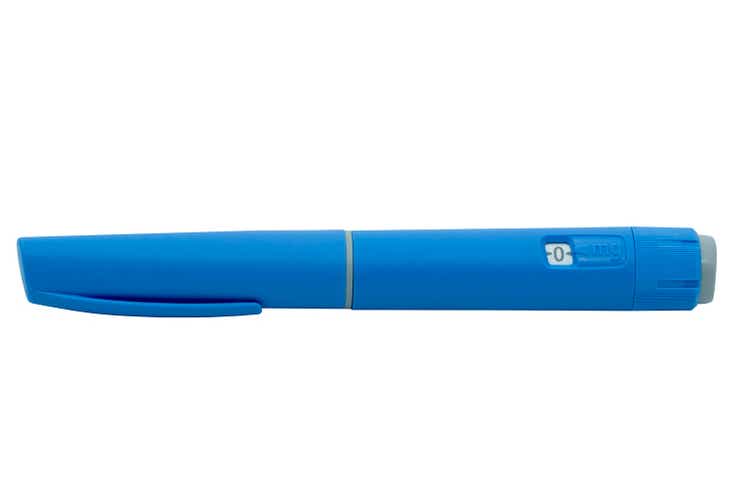Summary:
- Eli Lilly’s anti-obesity drug Zepbound (tirzepatide) receives approval in the US and recommended approval in the EU.
- The SELECT study data shows that semaglutide 2.4 mg reduces major adverse cardiovascular events and has additional benefits such as weight loss.
- The anti-obesity drug class is projected to generate $150 billion in US revenues by 2030, with injectables being the primary choice for the next 18 months. Oral medications are expected to be approved in 2025-2026.
KKStock/iStock via Getty Images
Over the past two weeks, there has been a spate of favorable news regarding the anti-obesity drug class, and Eli Lilly’s (NYSE:LLY) Zepbound in particular. Most importantly, Zepbound (tirzepatide) was approved in the US and the EMA recommended approval for obesity. In the US, Zepbound has a list price of $1,060 per month, which represents a 20% discount to Novo Nordisk’s (NVO) Wegovy. Lilly has also put into place savings programs for people who are commercially insured, with and without Zepbound coverage. Second, over the weekend, the SELECT study data was presented at the American Heart Association meeting. It should be noted that topline data of this study was released in August, and it showed that once-weekly semaglutide 2.4 mg was associated with a 20% reduction in major adverse cardiovascular events among a cohort with established cardiovascular disease who were obese or overweight with no prior history of diabetes (secondary prevention). The updated data, from a placebo-controlled trial of 17600 patients, showed that the beneficial effects were directionally consistent across prespecified patient groups. The reduced risk of the composite heart failure endpoint was 18%, and for all-cause death, 19%. There was also a 22% risk reduction of chronic kidney disease progression and renal death, and a 28% risk reduction of non-fatal myocardial infarction compared to placebo. A higher proportion of prediabetic patients on semaglutide (66% versus 22%) reached normoglycemia. As expected, the higher discontinuation rate in the semaglutide arm (16.6% versus 8.2%) was driven by gastrointestinal events. Importantly, given that the weight loss was 9.4% on semaglutide and 0.9% on placebo, the fact that the benefit curves began separating early may point to additional benefits of the drug, including reduced inflammation, improved left ventricular function and plaque stability. I note that it has been suggested that GLP-1s may prove efficacious in certain CNS disorders. It was estimated by Dr. Ania Jastreboff of the Yale School of Medicine that 6.6 million Americans met the criteria of the SELECT trial in 2018, up from 4.3 million in 2012.
I have previously discussed my forecast for the anti-obesity drug class, which suggests $150 billion in US revenues in 2030, dramatically exceeding a rising consensus estimate. Over the next 18 months, injectables from Novo and Lilly will be the therapeutic choices. In the second half of 2025 or early 2026, oral medications should be approved for both companies. While oral formulations result in less weight loss (15% versus 23% for tirzepatide), one should not analyze this market similarly to the statin market, where “lower is better” resulted in Lipitor and Crestor achieving dominant market shares. For about 20% of patients, a pill will be preferred over an injection, and there will also be patients for whom 15% weight loss is adequate. Some people may desire to switch to an oral medication as maintenance therapy once the initial weight loss has been achieved with an injectable. Therefore, it will be incumbent upon the physician to discuss therapeutic options and side effect profiles with each patient. As additional outcomes data becomes available over the next three years, more insurers, including Medicare, will allow for coverage for qualifying patients (based on BMI and predisposing conditions). As I noted in my last Lilly article, a study by the healthcare firm Accolade suggested that 43% of employers planned on covering weight loss drugs in 2024 versus 25% in 2023. Ninety-nine percent of employers currently covering GLP-1s for obesity expect to continue to do so. Additionally, the 6.6 million Americans who meet the SELECT criteria would equate to a US addressable market of over $50 billion at $8,000 per patient per year and $33 billion at my long term assumed price of $5,000. In the 2024-2027 time frame, many more GLP-1 class trials will read out that should demonstrate positive results in various chronic conditions and diseases, including NASH and sleep apnea.
I project Lilly to achieve EPS exceeding $50 in 2030 versus the consensus estimate of $40. I also expect EPS results in 2024 to surpass the consensus estimate of $12.35.
Analyst’s Disclosure: I/we have a beneficial long position in the shares of LLY, NVO either through stock ownership, options, or other derivatives. I wrote this article myself, and it expresses my own opinions. I am not receiving compensation for it (other than from Seeking Alpha). I have no business relationship with any company whose stock is mentioned in this article.
Seeking Alpha’s Disclosure: Past performance is no guarantee of future results. No recommendation or advice is being given as to whether any investment is suitable for a particular investor. Any views or opinions expressed above may not reflect those of Seeking Alpha as a whole. Seeking Alpha is not a licensed securities dealer, broker or US investment adviser or investment bank. Our analysts are third party authors that include both professional investors and individual investors who may not be licensed or certified by any institute or regulatory body.
